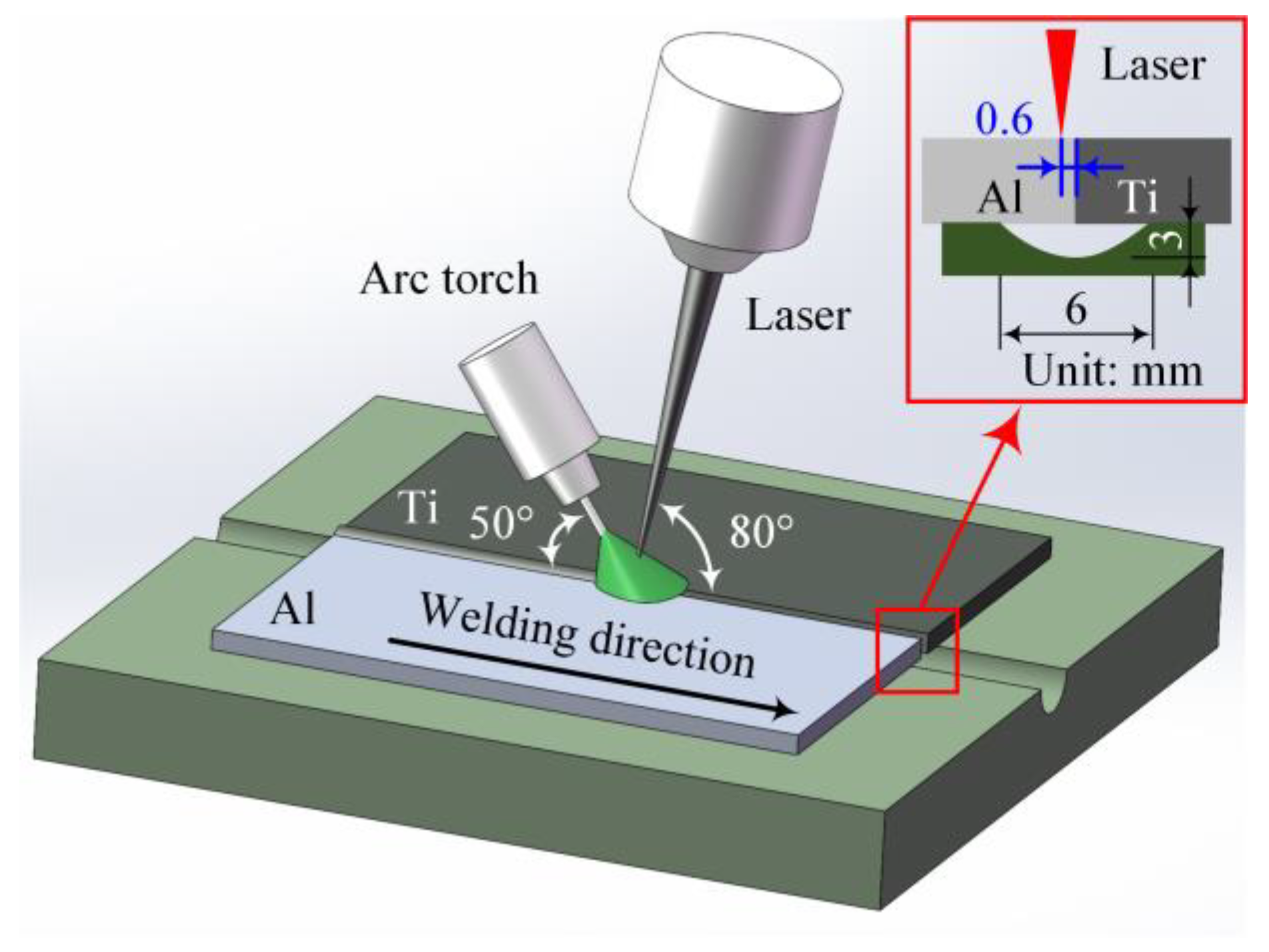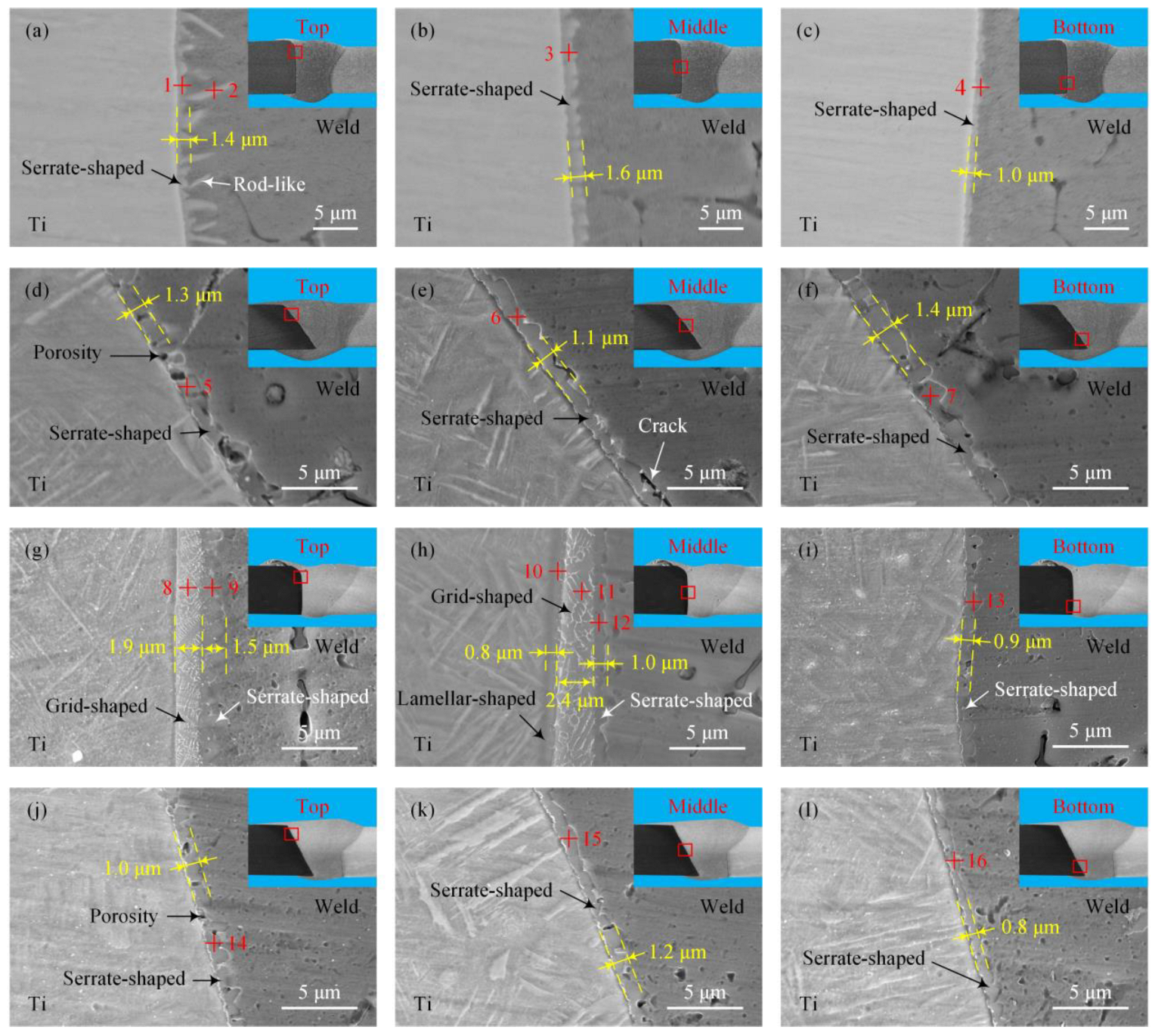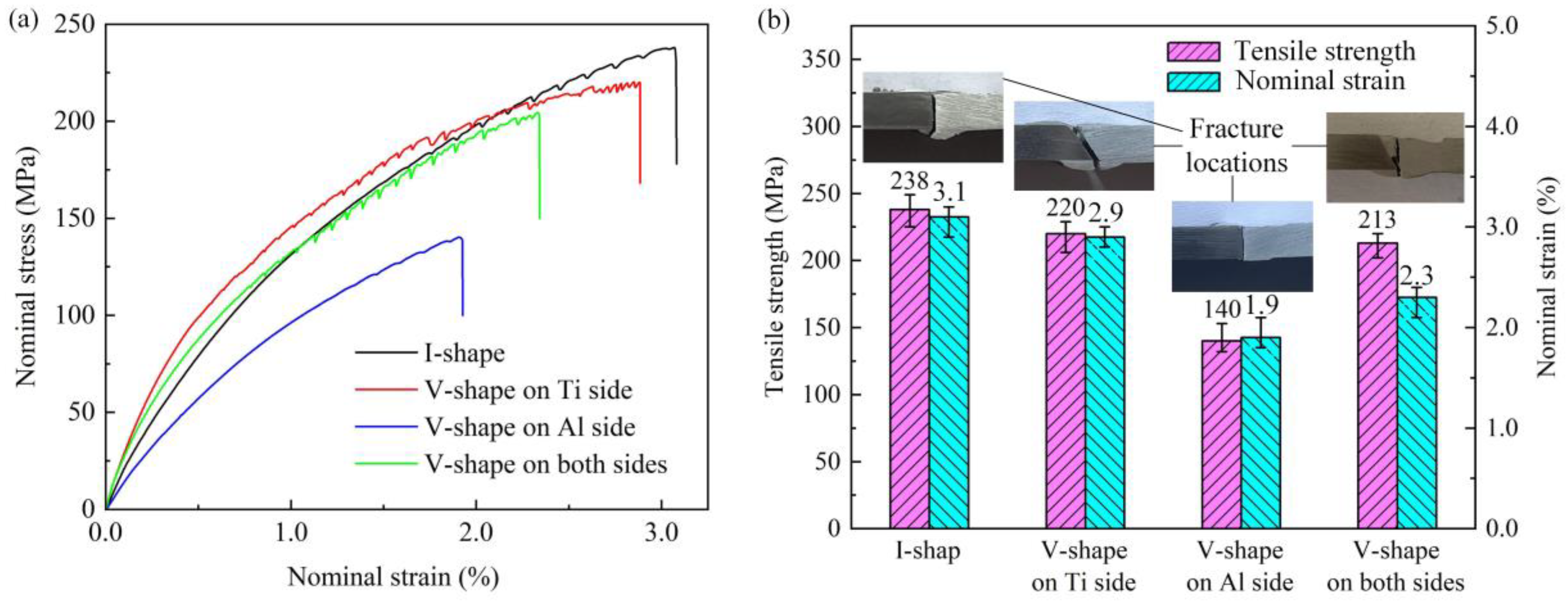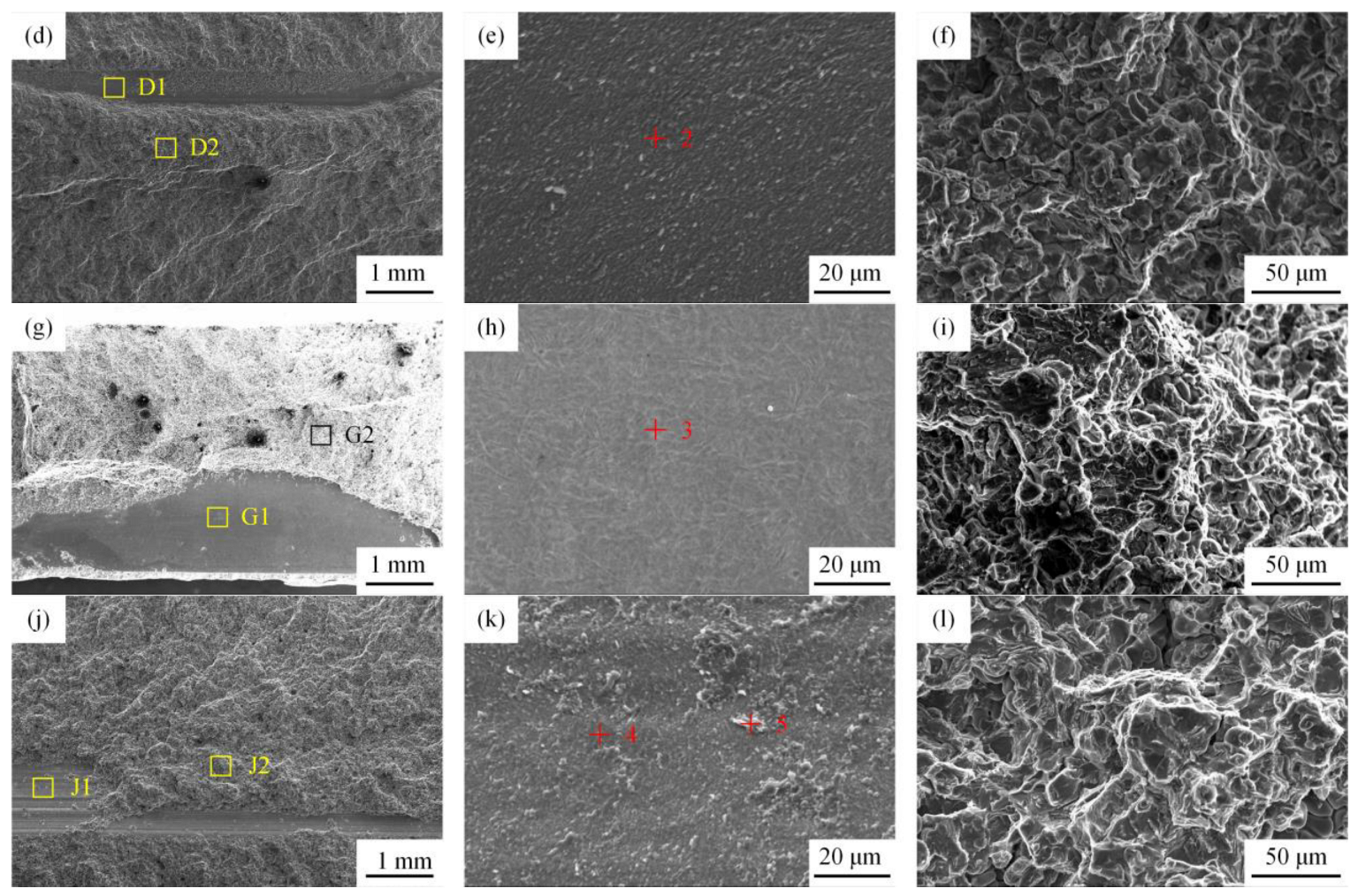Laser-MIG Hybrid Welding–Brazing Characteristics of Ti/Al Butt Joints with Different Groove Shapes
Abstract
1. Introduction
2. Materials and Methods
3. Results and Discussion
3.1. Weld Formation
3.2. Intermetallic Compounds
3.3. Tensile Property
4. Conclusions
Author Contributions
Funding
Data Availability Statement
Conflicts of Interest
References
- Xin, S.; Liu, X.; Zhang, S.; Zhou, W.; Li, Q.; Guo, D.; Guo, P.; Zhang, P. An overview on research and development of low-cost titanium alloys. Rare Met. Mat. Eng. 2023, 52, 3971–3980. [Google Scholar]
- Williams, J.C.; Boyer, R.R. Opportunities and issues in the application of titanium alloys for aerospace components. Metals 2020, 10, 705. [Google Scholar] [CrossRef]
- Liu, S.S.; Yue, X.; Li, Q.Y.; Peng, H.L.; Dong, B.X.; Liu, T.S.; Yang, H.Y.; Fan, J.; Shu, H.L.; Qiu, F.; et al. Development and applications of aluminum alloys for aerospace industry. J. Mater. Res. Technol. 2023, 27, 944–983. [Google Scholar] [CrossRef]
- Soni, R.; Verna, R.; Gary, R.K.; Sharma, V. A critical review of recent advances in the aerospace materials. Mater. Today Proc. 2024, 113, 180–184. [Google Scholar] [CrossRef]
- Möller, F.; Thomy, C.; Vollertsen, F. Joining of titanium aluminum seat tracks for aircraft applications system technology and joint properties. Weld. World 2012, 56, 108–114. [Google Scholar] [CrossRef]
- Zhao, H.; Yu, M.; Jiang, Z.; Zhou, L.; Song, X. Interfacial microstructure and mechanical properties of Al/Ti dissimilar joints fabricated via friction stir welding. J. Alloys Compd. 2019, 789, 139–149. [Google Scholar] [CrossRef]
- Quazia, M.M.; Ishaka, M.; Fazalb, M.A.; Arslanc, A.; Rubaieeb, S.; Qabane, A.; Aimana, M.H.; Sultanf, T.; Alig, M.M.; Manladanh, S.M. Current research and development status of dissimilar materials laser welding of titanium and its alloys. Opt. Laser Technol. 2020, 126, 106090. [Google Scholar] [CrossRef]
- Malikov, A.; Vitoshkin, I.; Orishich, A.; Filippov, A.; Karpov, E. Microstructure and mechanical properties of laser welded joints of Al-Cu-Li and Ti-Al-V alloys. J. Manuf. Process. 2020, 53, 201–212. [Google Scholar] [CrossRef]
- Chen, S.; Li, L.; Chen, Y.; Huang, J. Joining mechanism of Ti/Al dissimilar alloys during laser welding-brazing process. J. Alloy. Compd. 2011, 509, 891–898. [Google Scholar] [CrossRef]
- Chen, X.; Lei, Z.; Chen, Y.; Han, Y.; Jiang, M.; Tian, Z.; Bi, J.; Lin, S. Microstructure and tensile properties of Ti/Al dissimilar joint by laser welding-brazing at sub-atmospheric pressure. J. Manuf. Process. 2020, 56, 19–27. [Google Scholar] [CrossRef]
- Guo, S.; Peng, Y.; Cui, C.; Gao, Q.; Zhu, J. Microstructure and mechanical characteristics of re-melted Ti-6Al-4V and Al-Mg-Si alloys but weld. Vacuum 2018, 154, 58–67. [Google Scholar] [CrossRef]
- Nandagopal, K.; Kailasanathan, C. Analysis of mechanical properties and optimization of gas tungsten arc welding (GTAW) parameters on dissimilar metal titanium (6Al-4V) and aluminum 70575 by Taguchi and ANOVA techniques. J. Alloy Compd. 2016, 682, 503–516. [Google Scholar] [CrossRef]
- Xia, Y.; Ma, Z.; Du, Q.; Jiu, Y.; Guo, P.; Qin, J.; Li, S.; Zhang, X.; Zhou, P.; Hu, J.; et al. Microstructure and properties of the TiAl/GH3030 dissimilar joints vacuum-brazed with a Ti-based amorphous filler metal. Mater. Charact. 2024, 207, 113520. [Google Scholar] [CrossRef]
- Chang, S.Y.; Tsao, L.C.; Lei, Y.H.; Mao, S.M.; Huang, C.H. Brazing of 6061 aluminum alloy/Ti-6Al-4V using Al-Si-Cu-Ge filler metals. J. Mater. Process. Tech. 2012, 212, 8–14. [Google Scholar] [CrossRef]
- Gao, M.; Chen, C.; Gu, Y.; Zeng, X. Microstructure and tensile behavior of laser arc hybrid welded dissimilar Al and Ti alloys. Materials 2014, 7, 1590–1602. [Google Scholar] [CrossRef]
- Adamiak, M.; Wyględacz, B.; Czupryński, A.; Górka, J. A study of susceptibility and evaluation of causes of cracks formation in braze-weld filler metal in lap joints aluminum—Carbon steel made with use of CMT method and high-power diode laser. Arch. Metall. Mater. 2017, 62, 2113–2123. [Google Scholar] [CrossRef]
- Li, Z.; Zhang, Y.; Yang, Y.; Feng, J.; Zhang, L. Properties study on Ti/Al butt joining by GMAW/GTAW hybrid welding-brazing. Mater. Res. Express 2023, 10, 116518. [Google Scholar] [CrossRef]
- Zhou, X.; Zhao, H.; Liu, F.; Yang, B.; Chen, B.; Tan, C. Influence of energy ration on microstructure and mechanical properties in the transition zone of hybrid laser-MIG welded Ah36/316L dissimilar joints. J. Mater. Res. Technol. 2021, 15, 4487–4501. [Google Scholar] [CrossRef]
- Song, L.; Wei, S.; Rao, W.; Li, Z.; Zhang, Y. Optimization of welding parameters during Ti-TA2/5A06Al dissimilar double-sided cold arc metal inert gas welding. J. Mater. Eng. Perform. 2022, 31, 9714–9726. [Google Scholar] [CrossRef]
- Xu, W.; Wang, W.; Yang, Q.; Xiong, J.; Zhang, L.; He, H. CMT twin welding-brazing of aluminum to titanium. Weld. World 2022, 66, 1121–1130. [Google Scholar] [CrossRef]
- Leo, P.; D’Ostuni, S.; Nobile, R.; Mele, C.; Tarantino, A.; Casalino, G. Analysis of the process parameters, post-weld heat treatment and peening effects on microstructure and mechanical performance of Ti-Al dissimilar laser weldings. Metals 2021, 11, 1257. [Google Scholar] [CrossRef]
- Zhao, J.; Geng, S.; Jiang, P.; Song, M.; Xu, B.; Luo, Q. Experimental and numerical research on formation mechanism of intermetallic compounds in laser brazing welding for Ti/Al dissimilar alloy. J. Mater. Res. Technol. 2024, 31, 2930–2944. [Google Scholar] [CrossRef]
- Xia, H.; Zhang, S.; Wu, J.; Ma, Y.; Xu, L.; Li, H.; Yuan, J.; Yang, B.; Tan, C.; Wu, T. Homogenizing interfacial IMC distribution and enhancing strength of laser welded-brazed Al/Ti butt joint by oscillated scanning. J. Mater. Res. Technol. 2025, 35, 6226–6236. [Google Scholar] [CrossRef]
- Chen, X.; Lei, Z.; Chen, Y.; Han, Y.; Jiang, M.; Tian, Z.; Bi, J.; Lin, S.; Jiang, N. Effect of laser beam oscillation on laser welding-brazing of Ti/Al dissimilar metals. Materials 2019, 12, 4165. [Google Scholar] [CrossRef]
- Zhang, J.; Zhao, J.; Hu, K.; Gao, Q.; Zhan, X. Improving intermetallic compounds inhomogeneity of Ti/Al butt joints by dual laser-beam bilateral synchronous welding-brazing. Opt. Laser Technol. 2022, 146, 107533. [Google Scholar] [CrossRef]
- Casalino, G.; Leo, P.; Mortello, M.; Perulli, P.; Varone, A. Effects of laser offset and hybrid welding on microstructure and IMC in Fe-Al dissimilar welding. Metals 2017, 7, 282. [Google Scholar] [CrossRef]
- Shaker, M.A.; Jain, M.K.; Chen, J.Z. Deformation behavior of steel-to-aluminum tailor blanks made by laser/MIG hybrid and cold metal transfer brazing methods. Int. J. Adv. Manuf. Technol. 2020, 110, 3061–3076. [Google Scholar] [CrossRef]
- Gao, M.; Chen, C.; Mei, S.; Wang, L.; Zeng, X. Parameter optimization and mechanism of laser-arc hybrid welding of dissimilar Al alloy and stainless steel. Int. J. Adv. Manuf. Technol. 2014, 74, 199–208. [Google Scholar] [CrossRef]
- Xue, J.; Li, Y.; Chen, H.; Zhu, Z. Effects of heat input on wettability, interface microstructure and properties of Al/steel butt joint in laser-metal inert-gas hybrid welding-brazing. J. Mater. Process. Tech. 2018, 255, 47–54. [Google Scholar] [CrossRef]
- Zhao, Y.; Sun, H.; Zhao, X.; Zhao, H.; Liu, F.; Yang, B.; Chen, B.; Tan, C. The effect of inhomogeneous microstructure on the properties of laser-MIG hybrid welded 316L/AH36 dissimilar joints. J. Mater. Res. Technol. 2024, 28, 4088–4096. [Google Scholar] [CrossRef]
- Wang, W.; Zhu, Z.; Xue, J. Microstructure and mechanical properties of Ti/Al dissimilar joints produced by laser-MIG welding-brazing. Int. J. Mod. Phys. B 2019, 33, 1940030. [Google Scholar] [CrossRef]
- Tomashchuk, I.; Sallamand, P.; Méasson, A.; Cicala, E.; Duband, M.; Peyre, P. Aluminum to titanium laser welding-brazing in V-shaped groove. J. Mater. Process. Technol. 2017, 245, 24–36. [Google Scholar] [CrossRef]
- Li, P.; Lei, Z.; Zhang, X.; Cai, E.; Chen, Y. The microstructure and mechanical properties of dual-spot laser welded-brazed Ti/Al butt joints with different groove shapes. Materials 2020, 13, 5105. [Google Scholar] [CrossRef]
- GB/T 228.1-2021; Metallic Materials—Tensile Testing—Part 1: Method of Test at Room Temperature. Standards Press of China: Beijing, China, 2021.
- Kuryntsev, S. A review: Laser welding of dissimilar materials (Al/Fe, Al/Ti, Al/Cu)-methods and techniques, microstructure and properties. Materials 2022, 15, 122. [Google Scholar] [CrossRef] [PubMed]
- Chen, S.; Li, L.; Chen, Y. Interfacial reaction mode and its influence on tensile strength in laser joining Al alloy to Ti alloy. Mater. Sci. Technol. 2010, 26, 230–235. [Google Scholar] [CrossRef]
- Chen, Z.; Cai, C.; Yu, J.; Huang, J.; Chen, H.; Li, L. Microstructure evolution and fracture behavior of laser welded-brazed titanium/aluminum joints with various gap sizes. J. Mater. Res. Technol. 2024, 29, 714–727. [Google Scholar] [CrossRef]
- Chen, L.; Wang, C.; Xiong, L.; Zhang, X.; Mi, G. Microstructural, porosity and mechanical properties of lap joint laser welding for 5182 and 6061 dissimilar aluminum alloys under different place configurations. Mater. Des. 2020, 191, 108625. [Google Scholar] [CrossRef]
- Wei, S.; Li, Y.; Wang, J.; Liu, K. Influence of welding heat input on microstructure of Ti/Al joint during pulsed gas metal arc welding. Mater. Manuf. Process. 2014, 29, 954–960. [Google Scholar] [CrossRef]









| Metals | Al | Ti | Si | Fe | Cu | Mn | Zn | Mg | V |
|---|---|---|---|---|---|---|---|---|---|
| TC4 | 6.19 | Bal. | / | 0.21 | / | / | / | / | 3.95 |
| 5083 | Bal. | 0.12 | 0.34 | 0.37 | 0.08 | 0.65 | 0.19 | 4.57 | / |
| ER4043 | Bal. | 0.18 | 5.27 | 0.61 | 0.26 | 0.04 | 0.11 | 0.05 | / |
| Groove Types | Welding Speed (m/min) | Laser Power (kW) | Wire Feeding Speed (m/min) | Welding Current (A) | Welding Voltage (V) | Laser Offset Distance (mm) | Notes |
|---|---|---|---|---|---|---|---|
| I-shape | 1.5 | 2.2 | 6.5 | 112 | 18.2 | 0.6 | / |
| V-shape on Ti side | 0.8 | 1.8 | 8.0 | 180 | 21.7 | 0.2 | / |
| V-shape on Al side | 1.8 | 1.6 | 9.0 | 204 | 23.3 | 0.4 | / |
| V-shape on both sides | 1.8 | 1.5 | 7.5 | 126 | 18.8 | 0.6 | Backing |
| 1.5 | 1.5 | 9.0 | 204 | 23.3 | 0.6 | Covering |
| Locations | Al | Ti | Si | Possible Phase |
|---|---|---|---|---|
| 1 | 72.31 | 23.23 | 4.46 | TiAl3 |
| 2 | 71.62 | 24.73 | 3.65 | TiAl3 |
| 3 | 69.56 | 24.32 | 6.12 | TiAl3 |
| 4 | 77.24 | 21.21 | 1.55 | TiAl3 |
| 5 | 73.21 | 23.07 | 3.72 | TiAl3 |
| 6 | 75.34 | 23.91 | 0.75 | TiAl3 |
| 7 | 71.23 | 22.43 | 6.34 | TiAl3 |
| 8 | 56.32 | 42.21 | 1.47 | TiAl |
| 9 | 72.34 | 23.42 | 4.24 | TiAl3 |
| 10 | 28.89 | 67.91 | 3.2 | Ti3Al |
| 11 | 47.21 | 50.34 | 2.45 | TiAl |
| 12 | 71.54 | 22.45 | 6.01 | TiAl3 |
| 13 | 70.23 | 25.96 | 3.81 | TiAl3 |
| 14 | 77.33 | 21.24 | 1.43 | TiAl3 |
| 15 | 73.52 | 23.75 | 4.73 | TiAl3 |
| 16 | 74.27 | 24.46 | 1.27 | TiAl3 |
| Locations | Ti | Si | Al |
|---|---|---|---|
| 1 | 90.37 | 3.76 | 5.87 |
| 2 | 91.26 | 3.15 | 5.59 |
| 3 | 90.85 | 3.02 | 6.13 |
| 4 | 90.19 | 3.05 | 6.76 |
| 5 | 23.18 | 2.55 | 74.29 |
| 6 | 0.17 | 5.76 | 94.57 |
Disclaimer/Publisher’s Note: The statements, opinions and data contained in all publications are solely those of the individual author(s) and contributor(s) and not of MDPI and/or the editor(s). MDPI and/or the editor(s) disclaim responsibility for any injury to people or property resulting from any ideas, methods, instructions or products referred to in the content. |
© 2025 by the authors. Licensee MDPI, Basel, Switzerland. This article is an open access article distributed under the terms and conditions of the Creative Commons Attribution (CC BY) license (https://creativecommons.org/licenses/by/4.0/).
Share and Cite
Zhao, X.; Yang, Z.; Huang, Y.; Qu, T.; Cheng, R.; Lv, H. Laser-MIG Hybrid Welding–Brazing Characteristics of Ti/Al Butt Joints with Different Groove Shapes. Metals 2025, 15, 625. https://doi.org/10.3390/met15060625
Zhao X, Yang Z, Huang Y, Qu T, Cheng R, Lv H. Laser-MIG Hybrid Welding–Brazing Characteristics of Ti/Al Butt Joints with Different Groove Shapes. Metals. 2025; 15(6):625. https://doi.org/10.3390/met15060625
Chicago/Turabian StyleZhao, Xin, Zhibin Yang, Yonghao Huang, Taixu Qu, Rui Cheng, and Haiting Lv. 2025. "Laser-MIG Hybrid Welding–Brazing Characteristics of Ti/Al Butt Joints with Different Groove Shapes" Metals 15, no. 6: 625. https://doi.org/10.3390/met15060625
APA StyleZhao, X., Yang, Z., Huang, Y., Qu, T., Cheng, R., & Lv, H. (2025). Laser-MIG Hybrid Welding–Brazing Characteristics of Ti/Al Butt Joints with Different Groove Shapes. Metals, 15(6), 625. https://doi.org/10.3390/met15060625






